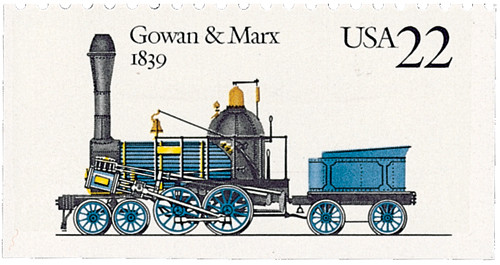
# 2362-66 FDC - 1987 22c Steam Locomotives
Â
22¢ Locomotives
Booklet Pane of 5 Stamps
City: Baltimore, MD
Quantity:Â 78,955,200
Printed By: Bureau of Engraving and Printing
Printing Method: Lithographed and engraved
Perforations: 10 horizontally
Color: Multicolored
Tom Thumb Proves The Power Of Steam

On August 28, 1830, the Tom Thumb steam locomotive impressed railroad officials during an impromptu race.
In the early days of the railroads, most railroads were generally tracks on roads. Horses would pull wagons with special wheels designed to ride on the rails. The first steam-powered locomotives were built in England and shipped to the US. Though Americans soon began trying to develop their own steam locomotives.

Among those Americans was Peter Cooper. Cooper was an inventor who later ran for president and founded the Cooper Union in New York. Convinced that the proposed Baltimore and Ohio Railroad would increase land prices in Maryland, Cooper purchased 3,000 acres and began developing them.  When the railroad experienced technical issues, Cooper saw his investment was in danger and decided to develop his own locomotive to help get the railroad back on track and to convince the owners of the B&O Railroad to use steam engines.

In the summer of 1830, Cooper built a four-wheel locomotive with a number of improvised parts, including the use of rifle barrels for boiler tubes. His newly designed locomotive was so small he called it the Tom Thumb. It was the first American steam locomotive to be used on a common-carrier railroad. In a series of test runs, the little engine attained speeds of eighteen miles an hour, almost twice as fast as a horse-drawn wagon. It also pulled one of the very first passenger trains.
Reportedly, on August 28, 1830, as Cooper was preparing the Tom Thumb for another test run, the driver of a passing horse-drawn car challenged him to a race. Accepting the challenge, the Tom Thumb easily pulled ahead early of the horse. However, when a belt slipped off the blower pulley, the engine lost power, allowing the horse-drawn car to win the race. In spite of this, the Tom Thumb’s early lead proved the speed that could be attained with a steam engine. The next year, the Baltimore and Ohio Railroad began testing steam engines, giving birth to the locomotive industry in America.
Although a history-making engineering achievement, the Tom Thumb proved to be too small for permanent use and was later disassembled. However, Cooper wrote down a detailed description of the train, which allowed for the creation of replicas in later years. You can view photos of the replica here.
Â
Â
22¢ Locomotives
Booklet Pane of 5 Stamps
City: Baltimore, MD
Quantity:Â 78,955,200
Printed By: Bureau of Engraving and Printing
Printing Method: Lithographed and engraved
Perforations: 10 horizontally
Color: Multicolored
Tom Thumb Proves The Power Of Steam

On August 28, 1830, the Tom Thumb steam locomotive impressed railroad officials during an impromptu race.
In the early days of the railroads, most railroads were generally tracks on roads. Horses would pull wagons with special wheels designed to ride on the rails. The first steam-powered locomotives were built in England and shipped to the US. Though Americans soon began trying to develop their own steam locomotives.

Among those Americans was Peter Cooper. Cooper was an inventor who later ran for president and founded the Cooper Union in New York. Convinced that the proposed Baltimore and Ohio Railroad would increase land prices in Maryland, Cooper purchased 3,000 acres and began developing them.  When the railroad experienced technical issues, Cooper saw his investment was in danger and decided to develop his own locomotive to help get the railroad back on track and to convince the owners of the B&O Railroad to use steam engines.

In the summer of 1830, Cooper built a four-wheel locomotive with a number of improvised parts, including the use of rifle barrels for boiler tubes. His newly designed locomotive was so small he called it the Tom Thumb. It was the first American steam locomotive to be used on a common-carrier railroad. In a series of test runs, the little engine attained speeds of eighteen miles an hour, almost twice as fast as a horse-drawn wagon. It also pulled one of the very first passenger trains.
Reportedly, on August 28, 1830, as Cooper was preparing the Tom Thumb for another test run, the driver of a passing horse-drawn car challenged him to a race. Accepting the challenge, the Tom Thumb easily pulled ahead early of the horse. However, when a belt slipped off the blower pulley, the engine lost power, allowing the horse-drawn car to win the race. In spite of this, the Tom Thumb’s early lead proved the speed that could be attained with a steam engine. The next year, the Baltimore and Ohio Railroad began testing steam engines, giving birth to the locomotive industry in America.
Although a history-making engineering achievement, the Tom Thumb proved to be too small for permanent use and was later disassembled. However, Cooper wrote down a detailed description of the train, which allowed for the creation of replicas in later years. You can view photos of the replica here.
Â











